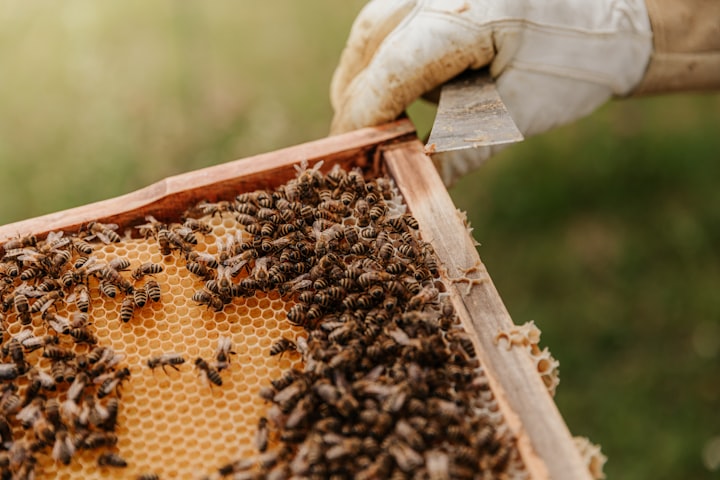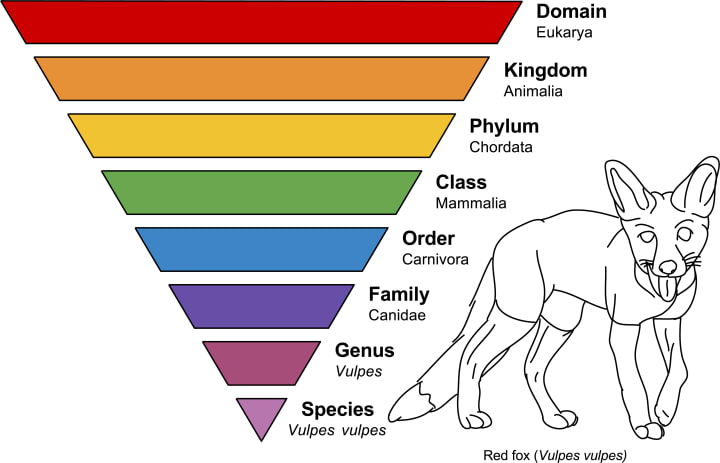Birds, Bees, and Inclusive Taxonomy
Discussing The Use of Language in STEM Fields

This article was written by Corey Batson and originally published in The Particle on 9/7/2021.
This week, I have been studying honeybees for work. They’re fascinating insects that play such important roles in our modern lives. Admittedly, I haven’t learned much about bees since 8th grade biology, so most of the information was practically new to me and made it even more fascinating. For instance, I knew that bees danced in order to communicate, but I was completely unaware that we knew how to translate that dance precisely!
What really caught me by surprise though was the language used to describe the different varieties of honeybees. I am an interpretive writer. Specifically, I research stuff to write about it for display in exhibits, museums, and nature centers. It’s an excellent job and I love the opportunity to learn about a wide variety of stuff. But this job also requires me to be aware of the words we use in scientific and communicative writing. When I see writing that appears to have racial undertones or exclusive connotations, I must examine this wording to determine whether its appropriate or if I should reword it for the signs or exhibits I’m working on.
So, what was it I found which warranted an examination of the language used to describe bees? In simplest terms, it is the use of the word “race” to describe different varieties within a single subspecies of honeybee. The classification of animals is nothing new. It’s how we scientifically distinguish that a White-tailed Deer is different from Mule Deer. This taxonomy helps scientists organize and group animals based on their characteristics. The problem is this:
Race is not a formally recognized taxonomic classification
Basics of Zoological Taxonomy
If you are not familiar with taxonomy, don’t worry, you don’t have to be in order to finish this article. You only need to know a couple things. When we give the scientific name of an animal, we are describing its taxonomic genus and species.
When I describe a Red-tailed Hawk (its common name) in its scientific name Buteo jamaicensis, I am describing its taxonomical place compared to other similar animals. It is a member of the genus “Buteo”, described as the soaring hawks or buzzards and its species is “jamaicensis” which is the descriptive term given to the Red-Tailed Hawk when it was first discovered. In short, there can be several Buteo species in the world, but only the Red-Tailed Hawk is Buteo jamaicensis.

Taxonomy doesn’t always stop there. There are fourteen recognized subspecies of Red-tailed Hawk. These subspecies can be noted by differences in their plumage, size variance, geographic origins, and more. To show this variance taxonomically, we would simply add a word after the species name. The Eastern Red-tailed hawk for example would be described as Buteo jamaicensis borealis. This allows scientists to classify smaller variations found within a recognized species.
Where Do Bee “Races” fit in Taxonomy?
In the hierarchy of taxonomy, a race would come after subspecies and before the groupings known as strains. But from a zoological standpoint, anything below subspecies is considered an informal classification in taxonomy. This means a taxonomic “race” is not a well-defined method of classification used throughout zoological taxonomy. According to the history of beekeeping, the labelled bee “races” are defined by their genetic lineage, place of origin, and physical colorations.
To me, these are all traits that can be described with the use of subspecies like shown above with the Red-tailed Hawk. With this in mind, “race” can be defined in a taxonomical sense exists as a placeholder for new systems of taxonomic classification. It all makes me ask, why even call it a race then?

Race as an Obsolete and Exclusive Term
As scientists, communicators, and more importantly as people, we need to regularly ask ourselves if the words we use have merit and forethought, or if they are relics of bygone, less inclusive times. As an example, let’s examine the terminology of “race” when applied to bees.
Scientifically, we have already explored how “race” in bee populations largely describes traits defined in the parent classification of subspecies. This alone should render the use of “race” obsolete. When we cross examine it with other species though, we continue to find evidence this terminology doesn’t belong.
Ants are another member Order Hymenopteran (a higher classification of insects containing both ants and bees in it). Despite many similarities between the two species, ants are not classified by anything lower than subspecies and no documentation I could find described ants by “races”. We can conclude that “race” is not a terminology regularly used in similar insect species.
When we consider the use of the term historically, we find that honeybees have been described using “race” terminology for at least 100 years. So there is certainly tradition of use regarding honeybees. What is troubling however is the language used around this terminology. In my research, I found when bee “races” were being discussed there were many cases where specific bee varieties were deemed “superior” to others. This was often tied to Italian or Caucasian varieties being the superior ones compared to the varieties coming from Egypt or Africa.
While the authors of these documents were trying to describe which bees were better suited to the climates they were being imported to (the Americas), the wording could have been considered more carefully. In modern articles, specific varieties of bees are described with the pros and cons associated to them. There is no superiority of one over the other, just a statement of which bees are more likely to swarm, less cold tolerant, or produce more honey. This leads me to believe the language used in older documentation was deliberate or just as likely language developed through a lens of preexisting systemic racism.

Reconciling our Language
Addressing racism and inclusivity in our language is not a new thing. As humanity begins to address the horrors of slavery and the need to rebuild systems that have historically harbored racism, scientists and communicators need to address the language historically used in the STEM field. It is not simply enough to claim a word use as a tradition when that use harms and discriminates against others.
Within the past three years the Tech Industry has begun working on removing its use of words like “master”, “slave”, “whitelist”, and “blacklist” from its collective terminology. While there is still debate on what words should be used instead, the effort is beginning to gain some traction despite initial verbal opposition. Similarly, NASA abandoned its use of the term “manned missions” years ago in favor of “crewed missions” to better represent the gender and general diversity within space science and space travel.
To some people this may seem like a pointless endeavor. How can the word choice be so important that we need to change an entire industry’s use of it? The problem lies in the history, perception, and language surrounding the use of those words. The words themselves don’t have to affect you to be problematic to someone else.

The use of “master” and “slave” in the Tech Industry may be the historical terminology describing something, it may have even been the language you were taught with. To an outsider though, someone just entering the field or someone just reading an article about coding, that language speaks to a connection between the industry and the racism that used those words to belittle Black people. Similarly, when a young girl reads about upcoming “manned” missions to space and sees only photos of male astronauts in her school textbook, she sees an industry meant for men alone.
When industries take the time to update their language however, people of all backgrounds and diverse perspectives can begin to feel welcome. Use of terminology like crewed missions helps to open the concept of space travel to all gender identities. Source and replica meanwhile are two suggested replacements for “master” and “slave” which better describe the meaning of the terminology without excluding an entire group of people through racial connections.
This trend is even beginning to extend beyond STEM and into the Arts as well. If you are a fan of Dungeons & Dragons like I am, you may have seen that there is a growing movement and consideration to drop the term “race” from the collective list of playable characters and NPCs. Terminology is still being discussed, but Jeremy Crawford, the lead designer of the player’s handbook and principal rules designer used “playable folk” to describe what has been traditionally called “races”.
Using Our Words to Celebrate Variety, Diversity, and Inclusion
Lets conclude by answering my initial question on whether using “race” to classify something is appropriate or inclusive. I’m not even sure honeybees need to be discussed using a classification more specific than subspecies. If they do, then I’m not sure “race” is the appropriate term to use.
The term “race” is an entirely unscientific relic from a system of belief that certain humans are less human than others. From a science standpoint, modern humans are not even formally classified beyond species. Understanding this and recognizing the pain that racial terminology has caused people and continues to cause people, I cannot comfortably use the term “race” when describing honeybees in a scientific manner.
But how do I describe them? Do we need to come up with an entirely new word?
Nope, we can just use “varieties”. When researching the honeybees and this terminology usage I found roughly half of the articles used the term varieties when describing specific lineages of bees. Like “race”, “variety” is also an informal classification found just below subspecies on the hierarchy. Historically variety was used to describe subspecies before the term subspecies was formally introduced in 1960.
If we absolutely must talk about honeybees in terminology more detailed than subspecies, then I propose variety replace the obsolete and exclusive terminology of “race”. Let’s talk about the variety of Italian bees instead!
Or hey, perhaps even the diverse variety of humans!

About the Creator
The Particle Publication
Particle — a minute portion of matter
While we never truly see them with our eyes, particles create the world as we know it, matter.
In that same theme, we bring to you The Particle. Each article written is a part of a larger picture.






Comments
There are no comments for this story
Be the first to respond and start the conversation.